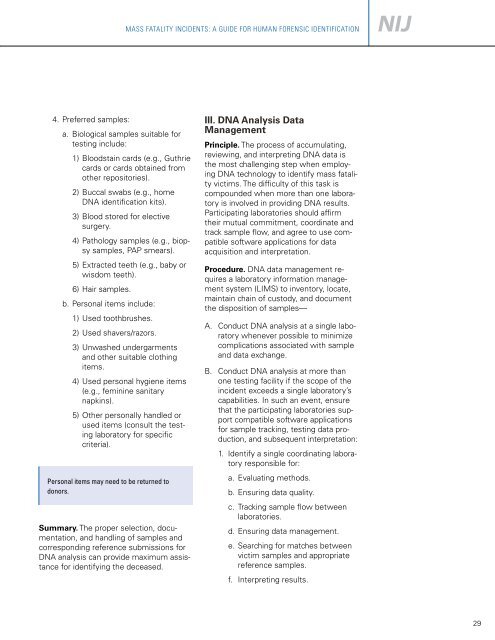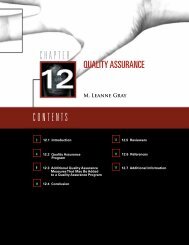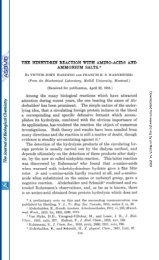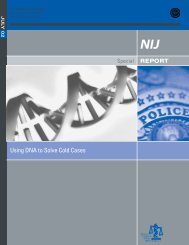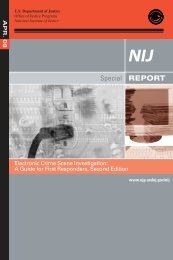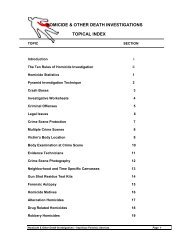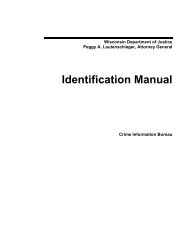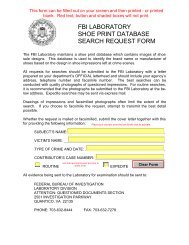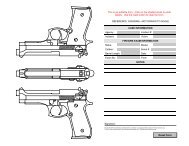Mass Fatality Incidents: A Guide for Forensic Identification
Mass Fatality Incidents: A Guide for Forensic Identification
Mass Fatality Incidents: A Guide for Forensic Identification
- No tags were found...
You also want an ePaper? Increase the reach of your titles
YUMPU automatically turns print PDFs into web optimized ePapers that Google loves.
MASS FATALITY INCIDENTS: A GUIDE FOR HUMAN FORENSIC IDENTIFICATION4. Preferred samples:a. Biological samples suitable <strong>for</strong>testing include:1) Bloodstain cards (e.g., Guthriecards or cards obtained fromother repositories).2) Buccal swabs (e.g., homeDNA identification kits).3) Blood stored <strong>for</strong> electivesurgery.4) Pathology samples (e.g., biopsysamples, PAP smears).5) Extracted teeth (e.g., baby orwisdom teeth).6) Hair samples.b. Personal items include:1) Used toothbrushes.2) Used shavers/razors.3) Unwashed undergarmentsand other suitable clothingitems.4) Used personal hygiene items(e.g., feminine sanitarynapkins).5) Other personally handled orused items (consult the testinglaboratory <strong>for</strong> specificcriteria).Personal items may need to be returned todonors.Summary. The proper selection, documentation,and handling of samples andcorresponding reference submissions <strong>for</strong>DNA analysis can provide maximum assistance<strong>for</strong> identifying the deceased.III. DNA Analysis DataManagementPrinciple. The process of accumulating,reviewing, and interpreting DNA data isthe most challenging step when employingDNA technology to identify mass fatalityvictims. The difficulty of this task iscompounded when more than one laboratoryis involved in providing DNA results.Participating laboratories should affirmtheir mutual commitment, coordinate andtrack sample flow, and agree to use compatiblesoftware applications <strong>for</strong> dataacquisition and interpretation.Procedure. DNA data management requiresa laboratory in<strong>for</strong>mation managementsystem (LIMS) to inventory, locate,maintain chain of custody, and documentthe disposition of samples—A. Conduct DNA analysis at a single laboratorywhenever possible to minimizecomplications associated with sampleand data exchange.B. Conduct DNA analysis at more thanone testing facility if the scope of theincident exceeds a single laboratory’scapabilities. In such an event, ensurethat the participating laboratories supportcompatible software applications<strong>for</strong> sample tracking, testing data production,and subsequent interpretation:1. Identify a single coordinating laboratoryresponsible <strong>for</strong>:a. Evaluating methods.b. Ensuring data quality.c. Tracking sample flow betweenlaboratories.d. Ensuring data management.e. Searching <strong>for</strong> matches betweenvictim samples and appropriatereference samples.f. Interpreting results.29


